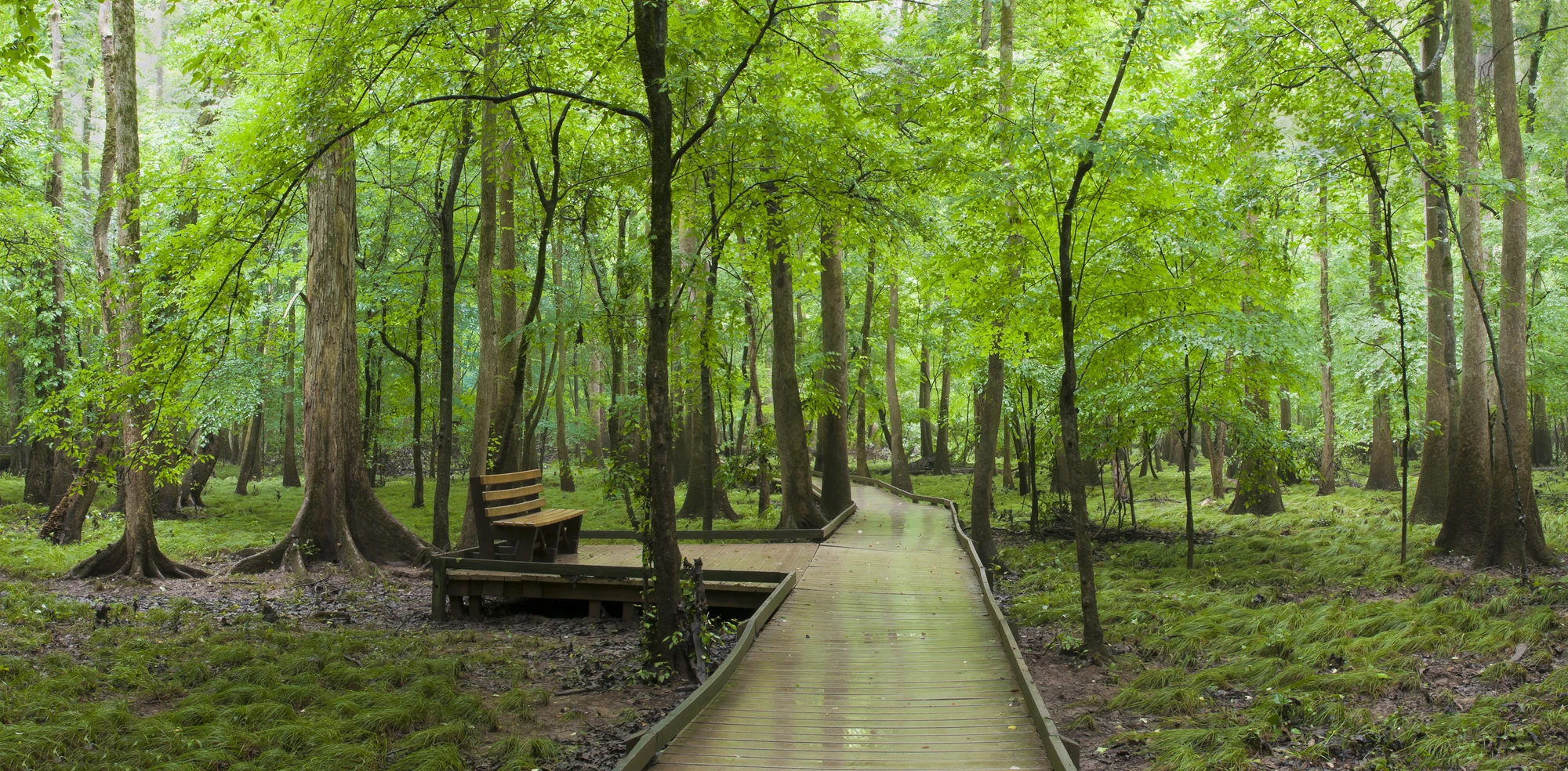Beneath the Cathedral of Cypress: Walking and Paddling Congaree's Floodplain Wilderness
A swamp cathedral of giant cypress, slow water, and quiet, old-growth wonder
Photo by Denton Rumsey
Shutterstock (ID: 140624515)
The boardwalk curves like a careful sentence through the swamp — raised planks threaded between knee-high cypress knees, past intermittent benches that invite a slow pause. Above, loblolly pines and bald cypress weave a vaulted canopy so dense light comes as a shy drizzle. Early morning at Congaree National Park feels deliberate: fog still clings to the floodplain, an invisible river pushes the air with a cool, damp heartbeat, and the forest, large and patient, seems to watch you back.
Trail Wisdom
Start at first light
Morning brings softer light, calmer waters for paddling, and fewer mosquitoes—aim to be on the trail or water within an hour of sunrise.
Pack a waterproof shoe
Beyond the boardwalk, trails can be muddy or flooded; lightweight waterproof boots or quick-dry shoes keep you comfortable.
Bring insect protection
Mosquitoes and ticks are common—use repellent, wear long sleeves in summer, and check for ticks after hikes.
Plan for limited service
Cell service is spotty—download maps, bring a physical map, and let someone know your route and return time.
Local Knowledge
Hidden Gems
- •Walk the Westfall Trail for quieter forest scenery beyond the main loop
- •Paddle late in the day along side channels to find secluded heron roosts
Wildlife
great blue heron, river otter
Conservation Note
Seasonal floods and invasive plant species are ongoing management challenges; visitors are asked to stay on trails and clean gear to prevent spreading invasives.
The area was named a National Monument in 1976 and redesignated Congaree National Park in 2003 to protect its extensive old-growth bottomland hardwood forest.
Seasonal Guide
spring
Best for: wildflowers and migrating birds, mild temperatures
Challenges: muddy trails after rains, increasing insect activity
Spring fills the floodplain with wildflowers and bird activity; be prepared for wet trails and rising bugs in late spring.
summer
Best for: long paddling days, lush green canopy photos
Challenges: high heat and mosquitoes, possible high water or storms
Summer is dense and humid—early starts and strong insect protection are essential; afternoon storms can close low trails.
fall
Best for: comfortable hiking conditions, muted fall color and clearer skies
Challenges: shorter daylight hours, cooler nights for camping
Fall is often the most comfortable season: cooler days, fewer bugs, and classic floodplain light.
winter
Best for: quiet trails and crisp air, distinct bark and canopy structure visibility
Challenges: cold mornings, possible flooding after storms
Winters are mild relative to northern parks but can be chilly; bare branches improve sightlines for birding and photography.
Photographer's Notes
What to Bring
Waterproof hiking shoesEssential
Keep feet dry and stable on muddy boardwalk edges and side trails.
Insect repellent (DEET or picaridin)Essential
Essential to manage mosquitoes and ticks, especially in warm months.
Lightweight rain shellEssential
Storms and sudden showers are common; a packable shell keeps you dry and warm.
Water purification system
Necessary for overnight trips if you’ll collect water from creeks or the river.
Common Questions
Do I need a permit to hike at Congaree National Park?
No permit is required for day hiking on maintained trails; backcountry camping does require a free permit — self-register at the Visitor Center.
Can I paddle in the park without experience?
Yes for short, calm stretches like Cedar Creek during normal water levels, but basic paddling skills and a float plan are recommended for longer trips.
Are trails wheelchair accessible?
The Boardwalk Loop is largely accessible and designed for easy access, but some side trails are uneven and may not be suitable for wheelchairs.
When are mosquitoes worst?
Mosquitoes are most active in late spring through early fall, especially in the mornings and evenings after rains.
Is there potable water and cell service?
The Visitor Center has potable water; cell service within the park is unreliable—download maps and prepare for limited connectivity.
Are dogs allowed in Congaree?
Pets are allowed but must be leashed and are generally restricted to front-country areas; they are not permitted on backcountry river routes — confirm current park pet policies before visiting.
What to Pack
Water filter (treat creek water); insect repellent (mosquito/tick protection); waterproof shoes (muddy trails); light rain jacket (sudden storms)
Did You Know
Congaree protects the largest contiguous tract of old-growth bottomland hardwood forest remaining in the United States.
Quick Travel Tips
Arrive early to avoid crowds; check visitor center for trail and water conditions; download offline maps; bring cash or card for nearby outfitter rentals.
Local Flavor
Nearby Columbia offers classic South Carolina barbecue, farm-to-table restaurants, and galleries; local outfitters provide guided paddles and interpretive tours that connect visitors to Swamp culture and ecology.
Logistics Snapshot
Location: near Hopkins, SC (about 20–30 minutes from Columbia). Essentials: bring insect repellent, waterproof shoes, water treatment for overnight trips. Permits: self-register for backcountry camping at Visitor Center. Cell service: limited.
Sustainability Note
Stay on boardwalks and established campsites, pack out all waste, and clean footwear and boats to avoid transporting invasive species between waterways.

